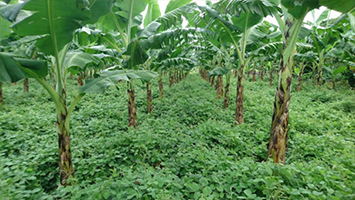With ‘Rain-fed, Mono-Crop Labour Intense Agricultural Practices’, prevail in the islands of Sundarbans. Rice is the staple diet and prime source of income for local land-holders, but the problem is soil and groundwater, say less than 1000 feet are high in salinity and not suitable for cultivation or household consumption.

There’re 1.4 million landless farm labourers whose livelihood is also connected to agricultural activities, but, unfortunately, without education or others skills, they go fishing or migrate elsewhere for work. Local farmers are ignorant of rain-water harvesting, composite cropping or soil management, as a result, they use a lot of chemical fertilizer… all these affect their yielding in long run. We teach farmers the model composite agriculture meant to multiply the crops in the same land at least two or three times a year.
We passionately train local youth and farmers belonging to Agrarian Communities on ‘Food Security’ through Sustainable Agri-Practices with Water Governance including Seed-Banking, Bio-Fertilizer making without using chemicals …which are extremely relevant in their local socio-economic context to maintain the health of soil and environment, create employments to ensure food security and to alleviating poverty.
Geographically isolated Sundarbans islands with extremely difficult transportation, the farmers are unable to make a good sale for most of their produces especially paddy and fruits. Our experts are teaching local farmers on sustainable food productions through bio-fertilizer making and drought and flood-resistant crop selection and forming ‘Farmers Syndicate’ for a fair price.
 Large-scale Rainwater Harvesting has no alternative in the agrarian islands of Sundarbans and many parts of Bengal. Many families here drink pond water, collected during the rainy season…is the reality of Sundarbans! The situation worsens during the rainy season as the low-lying areas get fully inundated usually by heavy rain, and with climate change, it has become even more unpredictable. By February all the canals and ponds run out of water and by April-May the underground water table goes down far below… meaning the ground hardly gets re-charged. Why…? It’s the clay soil layer – makes very thick hard-crust, doesn’t allow water to percolate into the heart-bed, and needs special technical intervention to do so. Fortunately one Scientist Dr. Arup has come forward with his technical innovation.
Large-scale Rainwater Harvesting has no alternative in the agrarian islands of Sundarbans and many parts of Bengal. Many families here drink pond water, collected during the rainy season…is the reality of Sundarbans! The situation worsens during the rainy season as the low-lying areas get fully inundated usually by heavy rain, and with climate change, it has become even more unpredictable. By February all the canals and ponds run out of water and by April-May the underground water table goes down far below… meaning the ground hardly gets re-charged. Why…? It’s the clay soil layer – makes very thick hard-crust, doesn’t allow water to percolate into the heart-bed, and needs special technical intervention to do so. Fortunately one Scientist Dr. Arup has come forward with his technical innovation.